In the subtropics, winter is a great time to grow many cool climate vegetables. The emphasis in my vegetable garden is always on fresh greens. Unless I buy them at a farmer’s market, I‘m not impressed by the freshness and diversity of shop bought greens. Many of my favourite winter greens such as corn salad, golden purslane, ice plant, tender butter lettuces, blanched moss-curled endives, raddichio and ice plants simply aren’t available commercially.

Palek paneer. Photo Vernon Chan. CC2.0
But above all, winter for me is about spinach, and one of my all time favourite dishes is palak paneer, traditionally a winter dish from northern India. Today it is available year round at most Indian restaurants and often simply called ‘spinach with cottage cheese’. It’s a mildly spiced dish of cooked and pureed spinach leaves with fried cubes of white cheese. It seems to be a great hit among many Australians.
Experiencing India
During the winter of 1999 I was lucky enough to get a Rotary Scholarship (Group Study Exchange) to northern India. India is larger than life, vibrant, colourful, noisy, fragrant and like no other country on earth. But above all, the delicious diversity of food left a lasting impression on me.
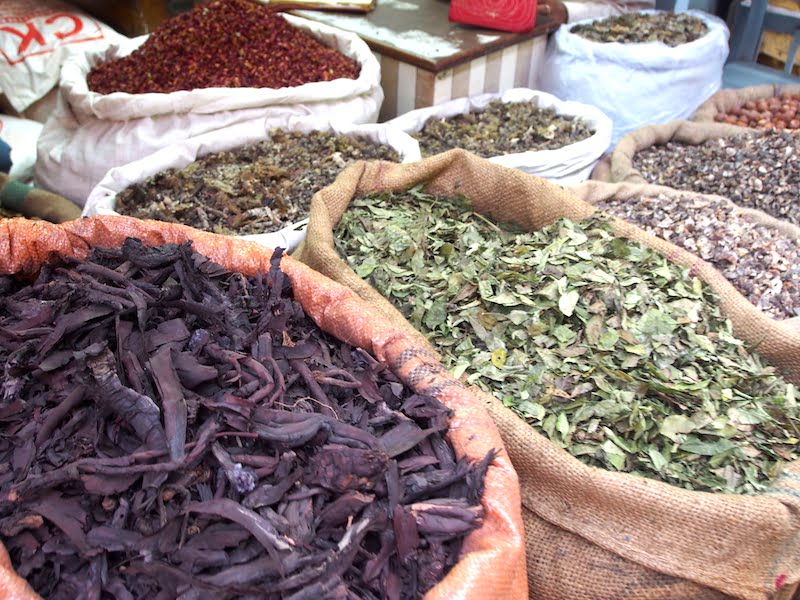
Chillies and other spices and dried herbs in the market
I stayed with families in various towns and cities in northern India and the family customs varied depending on the religion, caste and home cities of the husband and wife. As well as enjoying some delicious home cooking and learning about the history of various foods and dishes, I also tried various dishes shared at group get-togethers and special dishes served at weddings or festivals.
Whilst my taste buds were truly tantalized at every meal, one of my favourite dishes remains palak paneer in all its variations; and of course there are many in a country as populous and diverse as India.
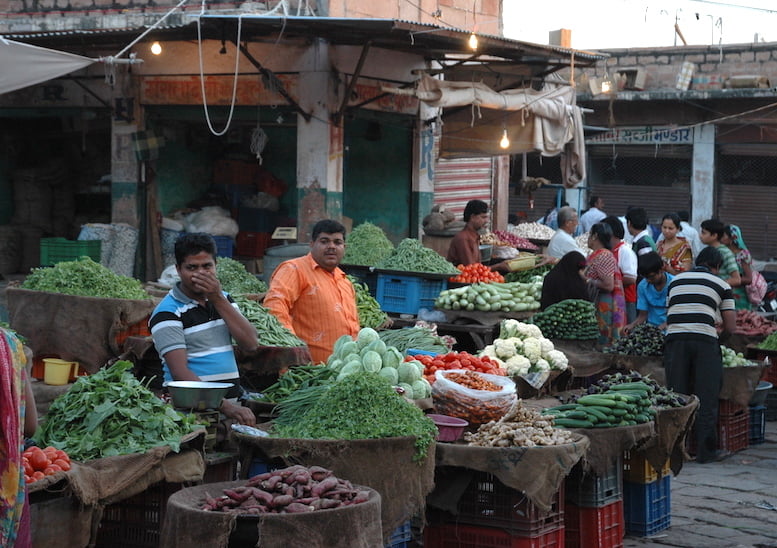
Fresh veg, herbs and spices in the market
Making palak paneer
Palak paneer is a remarkably simple dish to make, but whilst I have a vast library of Indian cookbooks (many lugged back from India at the recommendation of my hosts), I only started to try cooking the dish myself in recent years. The recipes I have tried vary vastly, as did the dishes I ate in India. Some I consider to be truly inspiring; others are not so memorable.
In many recipes the spinach leaves are coarsely chopped, in others they are pureed. Spices can vary widely, from very strong and complex to very mild and simple. In Australia spinach leaves are almost always used, however in India the leaves used in palak paneer can vary, depending on the season and locality.
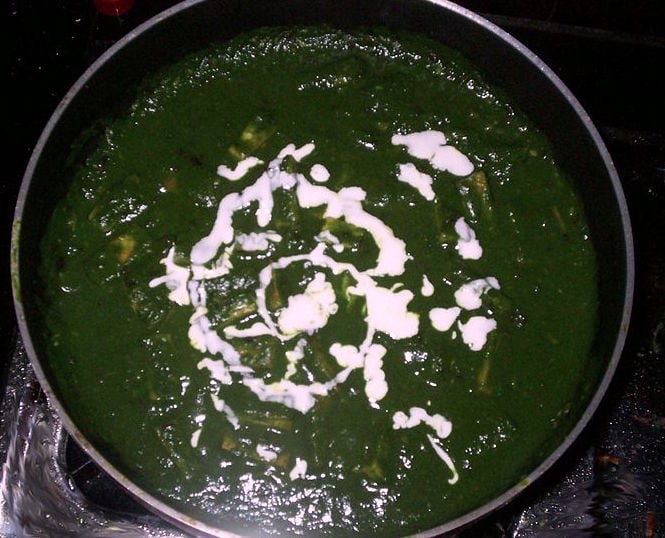
Palak paneer with a good dollop of cream. CC3.0
After much trialing, I admit that I have a soft spot for pureed leaves, along with a good dollop of cream. I also like some of the spices coarsely chopped or added as unground seeds so there are bursts of flavor as you enjoy the dish.
Palak paneer is made as 3 separate components; the leaves, the cheese, and the spice blend, and then all are combined.
Essential greens
Foggy, Brisbane winter mornings remind of the foggy mornings in Utter Pradesh and driving out through the fields where women in brilliantly coloured saris work amongst the lush green mustard leaves.
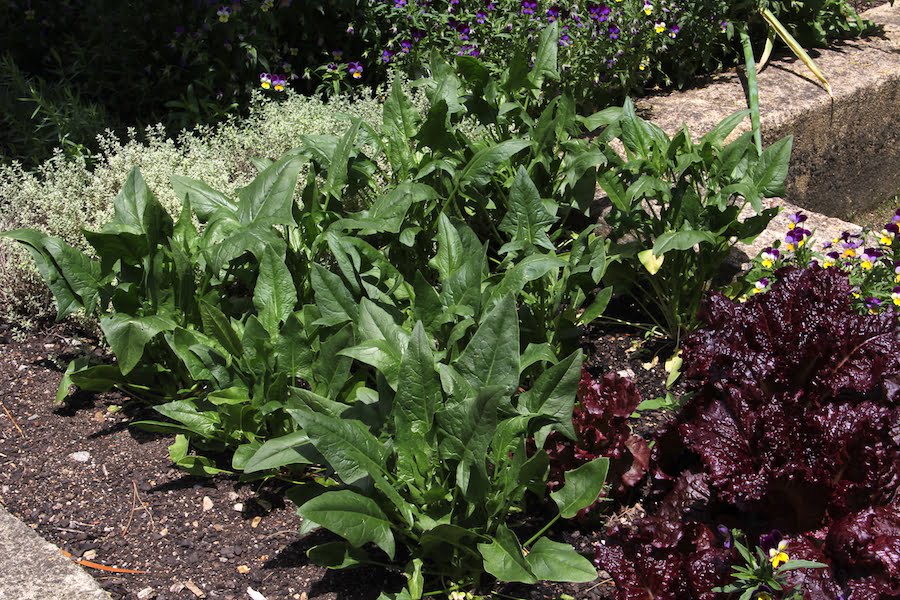
Spinach thrives during the cooler, winter months
Spinach (Spinacia oleracea) is often known in Australia as English Spinach. This often intrigues horticulturists, as the plant originates in ancient Persia (Afghanistan and Iran) and was grown in China by the 7th Century (where it was first recorded as the ‘Persian leaf’). It headed east to Africa and Europe (10th Century) and south into South East Asia. However it took until the 14th Century to finally be recorded in an England recipe. English it certainly isn’t.
I love spinach, with its delicious pungent and metallic flavor, and try to grow it each winter. However I regard it as a ‘diva vegetable’, as It is a fast growing annual plant and dislikes heat, drying out or lacking good nutrition. Get it wrong and the plant rapidly bolts to seed. I must grow it from May through to July and provide regular watering and fertilizing during the growing period to ensure good leaf production. I also sow seed in well-worked soil enriched with plenty of composted organic matter and organic fertiliser.
Spinach is classified into two groups. They are the summer (round seed) spinach which is slightly more heat tolerant, and the winter (spiny seeded) spinach, which is not so heat tolerant. Ensure you grow round seeded types as subtropical or warm temperate winters are more like European summers. Also get seeds into the ground early, as soon as the ground cools down (below 15 degrees), as increasing day length (from July) also encourages bolting.
While I have had no problem with insect pests or diseases, I find many warm-blooded creatures adore this plant. It must have a double line of defence in my garden, protecting plants under bird netting and within a fenced vegetable garden.
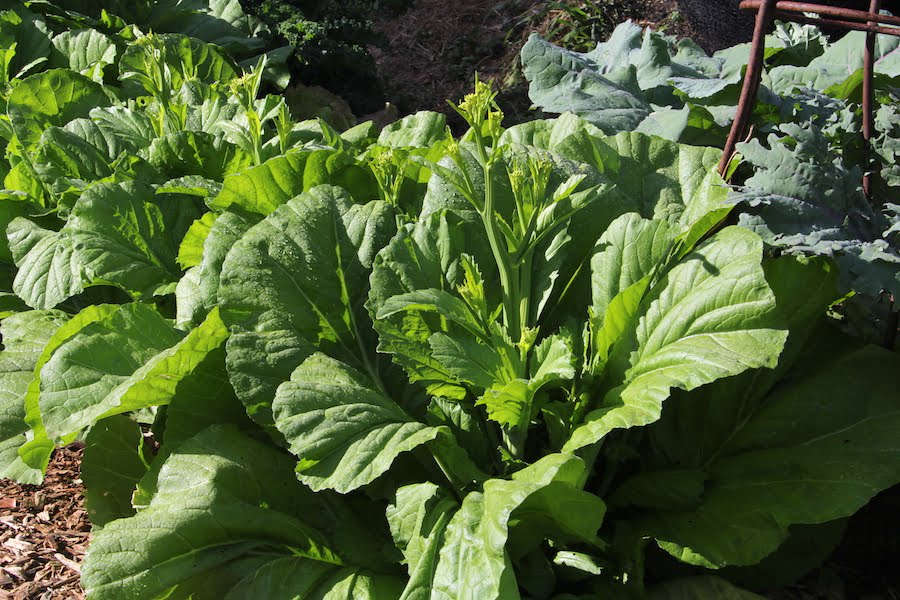
Saag can be harvested either as young plants or just before the flower stem emerges
The most popular vegetable for palak paneer in India is saag (Indian saag). It is a mild-flavoured mustard green (Brassica juncea) and introduces an acidic, mild mustardy flavor to the dish. Saag is an ancient vegetable recorded as being grown in India in 3000 BC. Recipes using saag, milk and spices date to 2000 BC.
In contrast to spinach, saag is a tough and vigorous growing plant. It forms very attractive, large rosettes of bright green leaves, reaching almost a metre (3 feet) across before flowering. Young plants suitable for harvesting can be dug within 4 weeks of sowing.
I sow seeds thinly in rows 500mm apart in late April or early May as soon as night temperatures fall below 15 degrees C (60 degrees F). Plants grow rapidly and after 2 to 3 weeks, plants can be thinned to 150mm apart, and these thinnings can be transplanted to other areas of the garden. As plants get bigger I thin to 300mm and then 600mm apart and start to harvest young plants. This keeps me going until mid August, when temperatures hit the 30s and plants bolt to flower and seed.
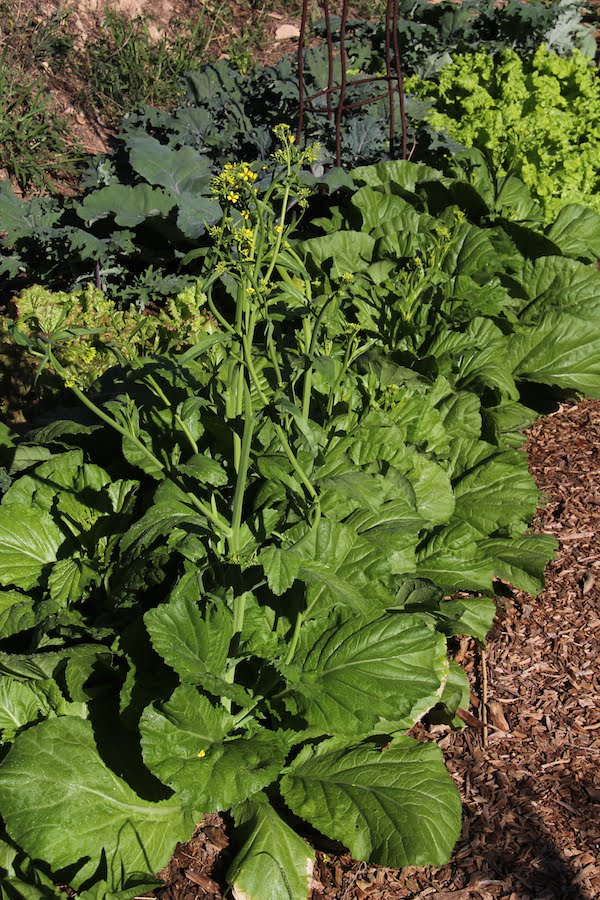
I let some saag plants flower each year and save seed
Saag is not available commercially so I let a number of plants go to seed so I can save seeds each year and share them with other growers. I originally got my seed from the Australian Seed Savers Network. Twice a year we would receive an extensive list of a huge variety of seeds offered by growers across the country. I believe my seed originated from the Siek community in Northern New South Wales, but know of no one else currently growing saag.
Inevitably when I harvest seed, a few fall to the ground, so every winter I find a few self sown seedlings in my vegetable garden. Some grow strongly in the most unlikely of locations, such as steep banks or thin, rocky, dry areas. This is truly a tough plant. An added benefit is that, unlike spinach, saag is totally pest and disease free. Wallabies and deer, that are frequent visitors to my garden, leave this plant strictly alone.
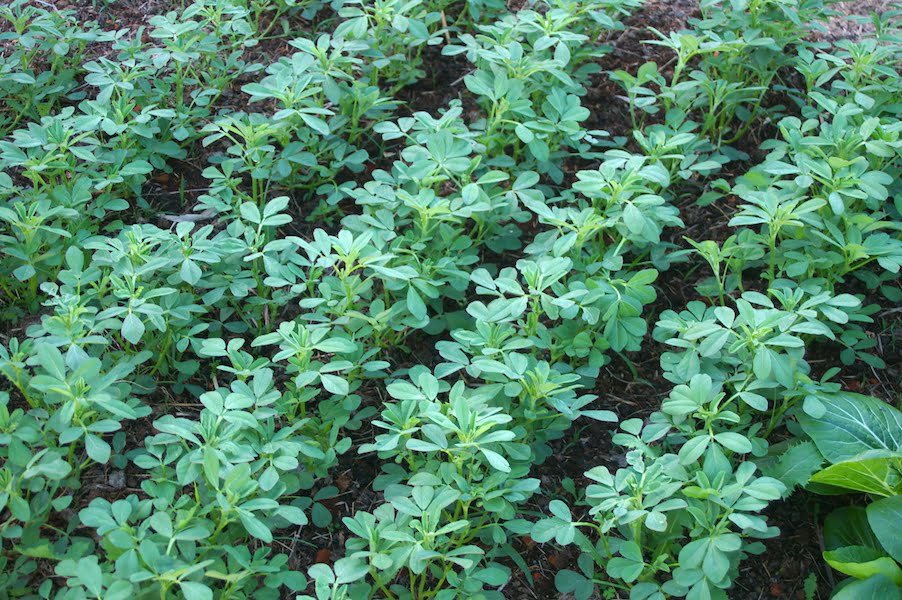
Fenugreek greens are great nitrogen fixers
The final popular palak paneer green is methi or fenugreek greens (Trigonella foenum-graveolens). Many people are familiar with fenugreek seeds, a popular spice; this is what they grow into when sown. It’s a very hardy, clover-like plant with a distinctive flavor. In India it is a popular winter garnish, shredded and topping many dishes.
Methi is another very hardy pest free vegetable. When I first moved to my current acreage property, I used to regularly run out of rainwater by the end of winter (our dry season) and had to give up on my vegetable garden until the rains arrived again. Methi amazed me as it just kept on growing, proving to be a very drought tolerant vegetable.
This hardy vegetable also reseeds itself each year with seedlings appearing as the cooler weather arrives. Its also a vegetable wildlife avoids. Another benefit from growing Methi is that it is a nitrogen fixing plant.
In India a small amount of methi leaves are added to the cooked green ingredients of a palak paneer. They are also used as a finely chopped raw garnish for this and man other dishes.
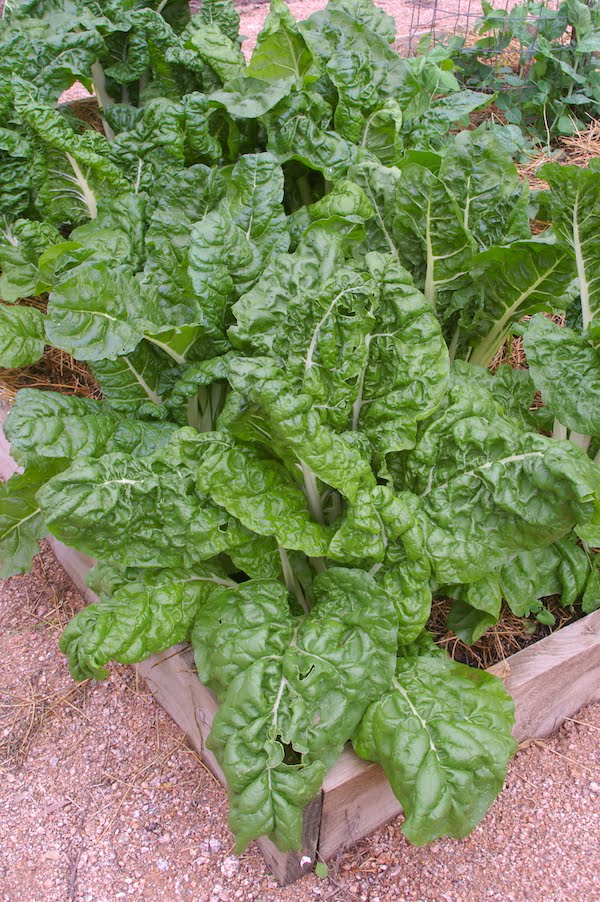
Silver beet is a hardy reliable vegetable
Silver beet, chard or South European spinach (Beta vulgaris) is another great leafy green for palak paneer. It grows vigorously during the cooler months, quickly forming large plants with quantities of leaves that can be harvested, a few at a time from various plants. I have a particular love of the coloured leaf stem (petiole) varieties such as ‘Ruby Red’ with their fluorescent colours, which also include pink, yellow and orange varieties.
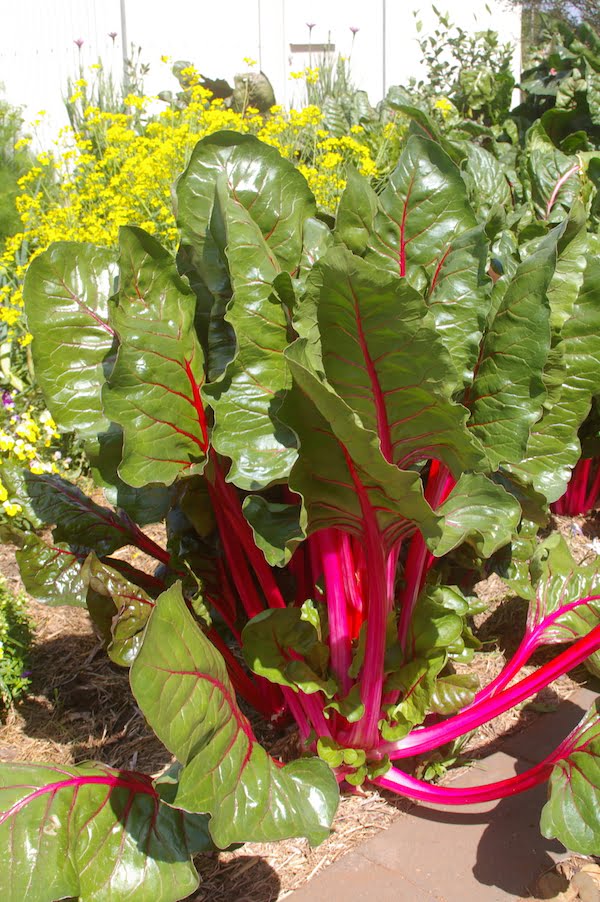
Red stemmed beet looks stunning in the garden
I find silver beet is best sown in autumn or early winter. Plants appear to lose vigour and bolt by summer, so are best removed to make way for summer crops.
To prepare silver beet leaves for cooking, they need to be trimmed from the fleshy leaf stems. The leaves are a little more fibrous than other ‘spinaches’ when pureed.
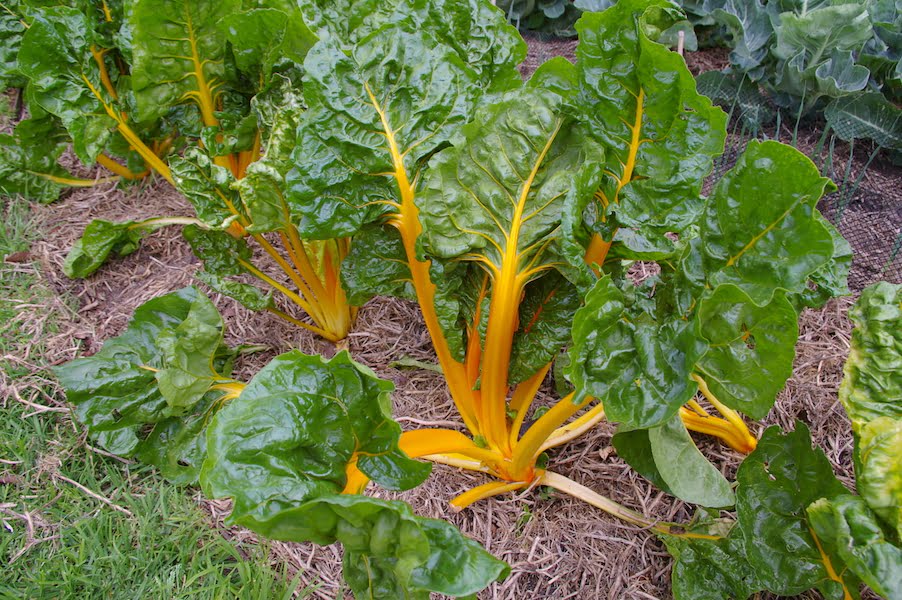
Silver beet can also have golden-yellow stems
New Zealand spinach or Warrigal greens (Tetragonia tetragonoides), is another standard in my vegetable garden. It thrives over the autumn, winter and spring months, but grows less vigorously during the summer, and can die completely out during very hot or very wet summer weather. However it produces plenty of seed and by April, the seedlings are germinating and plants are big enough to harvest young leaves by mid May. I set aside a patch some 2 x 3 metres (6.5 by 9 feet) for this plant and if it dies out can oversow the area with a quick summer crop, to clear by April.
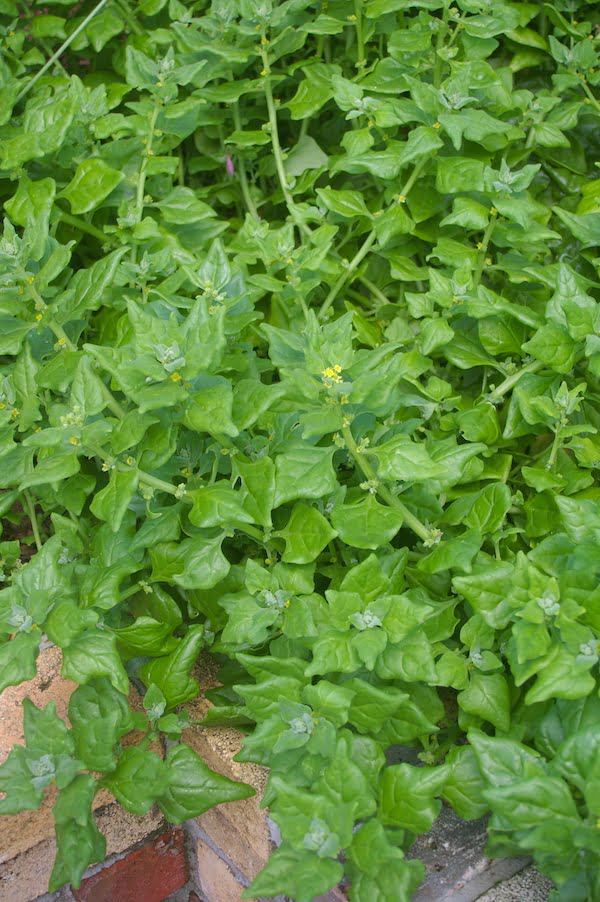
Tetragonia at Auckland Botanic Gardens
Many people have difficulty growing New Zealand spinach, and I must admit I didn’t have much success until I got a plant from the late Isabel Shipard, a well known Queensland herbalist, author and teacher. I regularly bought unusual herbs or spices from her over the years, and must have commented on my lack of success when seeing her thriving patch of the plant. She gave me a plant to try and I must admit, I probably would have given up on this plant if it was not for Isabel.
Isabel’s plant has broad, tender, mid green leaves with a mild flavor and seems to differ from many of the wild Australian plants I see or plants sold or grown by greening groups. These have darker green coarser and more triangular shaped leaves.
This species has a broad distribution, including New Zealand and Australia, but also extending west into the Pacific Islands and north to Taiwan, Japan and China. I understand that the cultivated forms of the species have lower oxalic acid levels than the wild forms. My plant is very tender and when cooked can fool people who are convinced they are eating fresh spinach. I am fairly sure I am growing a cultivated New Zealand clone, which Isabel has selected over many decades for vigour in our subtropical climate. My tip is to locate gardeners with similar plants in your locality and harvest seeds or take cuttings of a good tasting and pclimate appropriate clone.
This is another pest free plant which wildlife leave completely alone. It helps to extend my spinach season, often throughout the year.
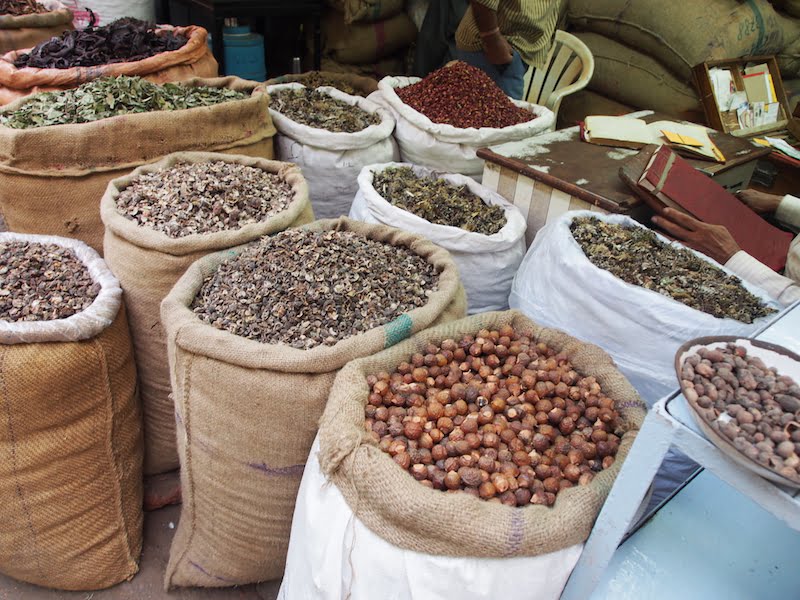
Pungent and colourful spices in an Indian market
Spices
India is famous for its use of spices, and for me, the spice markets are fascinating places to visit, like an Aladdin’s cave of miraculous ingredients. Sacks of brightly coloured turmeric or chilli contrast with the varied textures of dried cinnamon sticks, cloves or coriander seeds. The markets have an incredible mix of aromas and the vendors encourage customers to smell and taste the spices so they can appreciate the quality and freshness of their fare. The smells and tastes remind me of India.
In Brisbane, spices are often a lot easier to grow than the more traditional Mediterranean herbs, which (with the exception of oregano, mint and Jekka’s thyme), often drop dead when our warm, wet summers arrive (they must have warm dry summers). I replant my favourite herbs each April as the weather cools.
I grow most of the perennial spices and a few of the annuals and this gives me the option of using either fresh or dried versions.
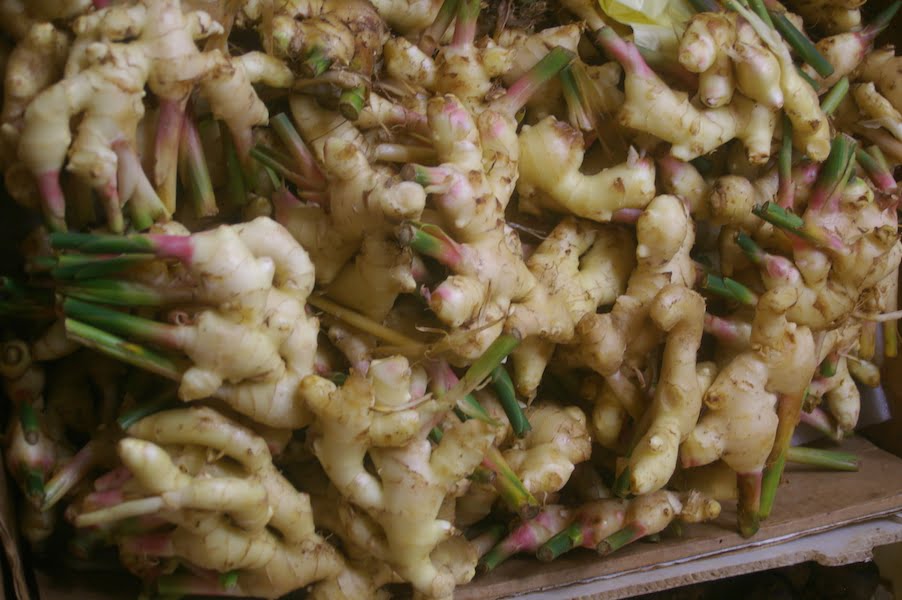
Freshly harvested green ginger rhizomes
Ginger (Zingiber officinale) thrives in the subtropics. Lets face it, just north of Brisbane is one of the worlds largest ginger growing area; a hint that it should be planted in every warm climate garden.
Many different clones of ginger grown. In Asia different cultivars are used for medicinal and culinary purposes. Sweeter, spicier or sourer clones also exist and are used for specific sweet or savoury dishes. Many of these clones are grown in Australia but are not so easy to source. The flavor of ginger also varies depending if it is freshly harvested (‘green’) or has been dried and cured for a while. During autumn and early winter, freshly harvested ginger comes on the market.
In recent years higher yielding clones with larger tubers have dominated the market. However many growers are now growing the older ginger clone with the smaller rhizome again, as it is much more disease resistant and tolerant of climatic extremes. I grow this clone myself as hardiness is important in the home garden and I thought that this trusted clone was about to disappear completely.

Ginger plant. Generally they flower from the base of the plant
Ginger quickly forms a tight clump of arching stems in the garden. It responds well to organically enriched soils, regular water during the growing season and consistent fertilizing. Green rhizomes can be harvested as required by digging from the edge of the clump. They have a much sharper flavor than the dried rhizomes.
The plant will defoliate completely with the onset of drier, cooler weather. In my garden, this tends to happen in mid to late June. Rhizomes can be dug and harvested, and the young vigorous rhizomes replanted in freshly prepared soil to ensure good production next year. I don’t really get round to doing this each year, but try to do it every 3 years to keep the plants growing vigourously.
Root production occurs when ginger is most need – for Palak paneer and to add to tea and other dishes, to warm and stimulate the body and keep winter colds away. I like to chop ginger rather coarsely in Palak paneer to provide little bombs of flavor on the tongue.
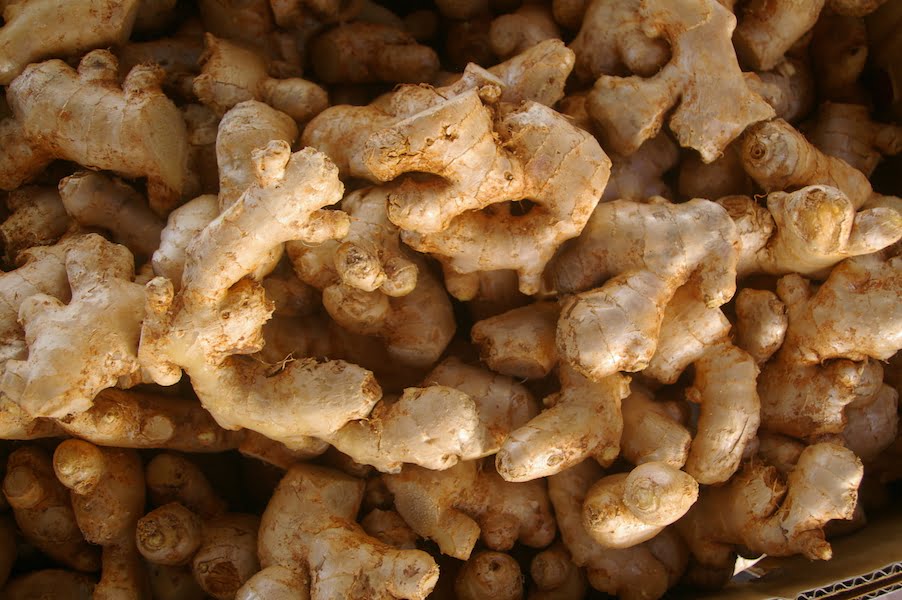
Dried ginger rhizomes
Paneer
The cow is the most sacred animal in India. Archeological evidence confirms that cattle were domesticated in the Indus Valley by 7000 BC. White Brahman cows with their large eyes and long eyelashes seem to be everywhere, often on busy, polluted and noisy city street. They quietly forage for food (including paper, cardboard and plastic bags) or sit placidly, munching cud on a traffic island or footpath. Apparently every cow is known by name and has an owner
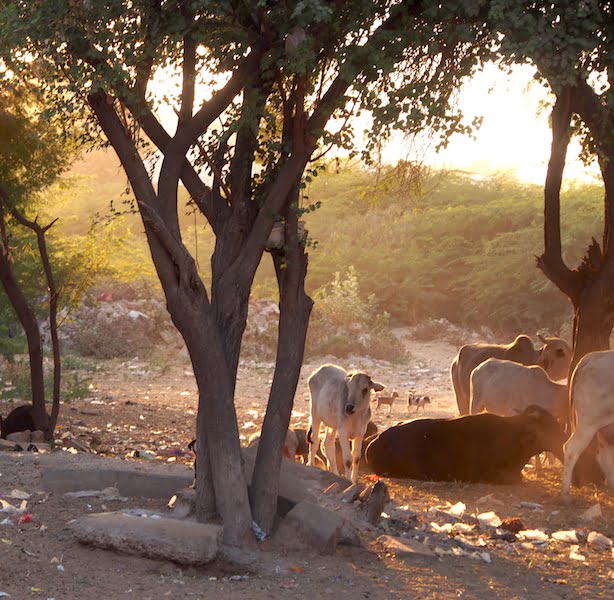
Cattle forage through street rubbish in India
Paneer is an ancient cheese and an essential ingredient in Palak Paneer. It was invented by accident when the Mongols carried milk on horseback in leather bags, which caused the milk to curdle. By the 1500s, and the reign of Akbar, Palak Paneer as we know it is recorded from the Royal recipes of the Mughal (Moghal) empire of northern India. The Punjabis are said to have refined this recipe, and this is the style we eat in many Australian restaurants today.
I have heard of people substituting haloumi when they cannot source paneer. However it is easy to make at home, simply bring full cream milk to simmer, add lemon juice and allow it to cool and curdle. Strain through muslin cloth, keeping the whey for other dishes. Stringing the muslin from a kitchen tap and leaving it to drip overnight forms a good cheese.
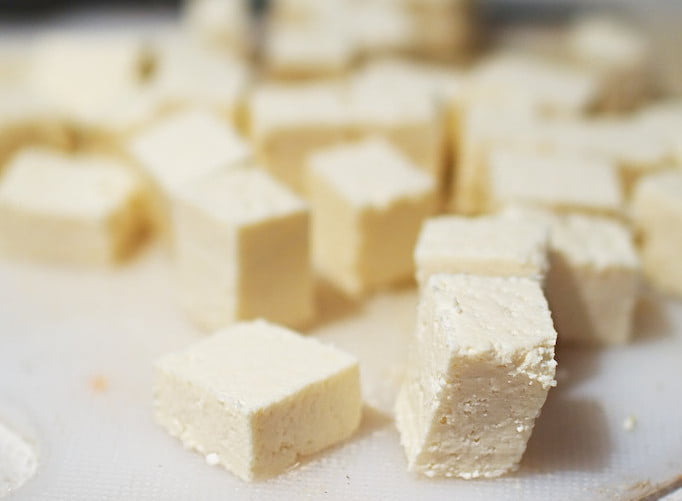
Making fresh paneer. Photo VirtualWolf via Flickr. CC2.0
I must confess that I have an excellent Indian grocery store nearby, and these days tend to buy my paneer there (as well as some spices, a samosa or two and some Indian sweets).
How to make Palak Paneer
There are many variations on Palak Paneer and I would recommend trying various versions at restaurants and talking to staff about making the dish. I have found all restaurants happy to share their techniques and ingredients. You’ll also find various recipes in Indian cookbooks and also on the internet.
After trying many versions myself, I found I like recipes that are:dark green in colour and not overcooked (frozen spinach is often dyed a bright green)pureed to a smooth texturecrisp golden fried paneer with softer centresspices to match the leaves – stronger with more flavourful leaves like saag and milder with spinach.Some of the spices, such as ginger or coriander chopped coarsely to provide little bombs of flavorA good dollop of double cream!
Ingredients
750 gms spinach – I like two thirds spinach, one third saag (Indian mustard greens) and a little methi (fenugreek) leaves. You can also use many other spinach greens such as: silver beet (chard), beetroot tops, New Zealand spinach, dandelion leaves, basella, abika, Surinam spinach, Ethiopian cabbage, kale (well cooked and preferably ‘Red Russian’), amaranthus (Chinese spinach) or Lagos spinach.
3-4 tbsp ghee or butter
400 gms paneer cut into 2cm cubes
spices:
1 tsp garam masala
1 tsp crushed coriander seeds
1 tsp cumin seeds
2-3cm chopped ginger
3-6 chopped garlic
1 green chilli
As noted above, spices are adjusted to the leaves used
1 tbsp tomato paste
3 tbsp cream
Preparation
Wash, chop and wilt leaves quickly until tender, with the water from washing still on them. Quickly place in icy water to stop cooking and keep the colour, then drain. Puree and set aside.Melt 1-2 tbsps of ghee or butter in a non-stick frying pan. Fry paneer on all sides until slightly golden and crispy.Melt 1-2 tbsps of ghee or butter in pot. Fry garam masala, add crushed coriander, cumin, then ginger and garlic, and finally add tomato paste.Combine all ingredients above together, add cream and warm through. Serve.
With practice you can do steps 1 to 3 concurrently to speed up cooking.
Many recipes include fried chopped onions, whole tomatoes, cashew or almond paste. I suggest you try a few recipes to see which variations you prefer.
Traditionally Palak Paneer is eaten for breakfast, lunch or dinner, and generally with an Indian bread such as naan or roti.
Next time your thinking of going out for dinner, try an Indian restaurant and order a palak paneer. You may become a convert, and just like me, each year as winter approaches, start growing some of the ingredients in your own garden. Enjoy perfecting your own palak paneer.
